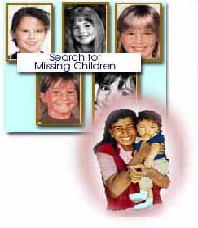|
Missing Children
Locator Agent
The Problem
Photographs are extremely important in cases involving missing
children, but law enforcement officers do not have the tools to quickly
and conveniently compare photographic images with database galleries
of missing children.
With the explosion
of Internet use, vast amounts of available open-source data may be
relevant to missing children cases. Children and parents are creating
home pages, and schools are publishing yearbooks on the Internet.
At the same time, pornography circulated with the aid of the Internet
may also contain faces of missing and exploited children. Law enforcement
officers do not have the tools that would enable them to find important
clues hidden on the Internet.
The Solution:
Missing Children Locator Agent
The ANSER team, funded under National Institute of Justice Cooperative
Agreement 98-LB-VX-K021, is developing a system of intelligent software
agents integrated with face recognition engines. Intelligent software
agents continuously and autonomously search the Web for images, capture
and process these images to form probe queries, activate a search
engine to compare the probe against a database gallery of missing
children, and find the most probable matches between the probe and
the gallery of missing children. As the search continues, the Missing
Children Locator Agent system maintains and updates a list of best
matches for each gallery image. A case manager can periodically access
and review the resulting list of best matches for each missing child
through a dynamically generated web-based user interface, over the
Internet or an intranet.
As an additional
feature, a user can submit an input probe image as a query, which
may be entered remotely or over the Internet. The probe query will
be compared with a database gallery of missing children. The user
can inspect the closest matches between the query image and the best
matches to missing children in the database gallery.
ANSER released
a beta version of the Missing Children Locator Agent system for test
and evaluation to the West Virginia Missing Children Clearinghouse
in the Fall of 1999 as part of a pilot initiative with the West Virginia
State Police Missing Clindren's Clearinghouse .
Other Law Enforcement
Applications
A second application integrates the recognition components of this
system with a digital booking system. A law enforcement officer could
quickly query the booking system with images of suspects that have
been captured on film or in artists' sketches based on eyewitness
accounts. This system could be used in the field by equipping patrol
cars and surveillance vans with digital cameras, laptop computers
or digital terminals, and wireless communication equipment. Law enforcement
officers could capture images of suspects and transmit those images
back to the station to automatically query the booking system or other
related systems. The top image matches would be returned in near-real
time to the officer in the field, who could determine whether any
outstanding warrants exist.
|
